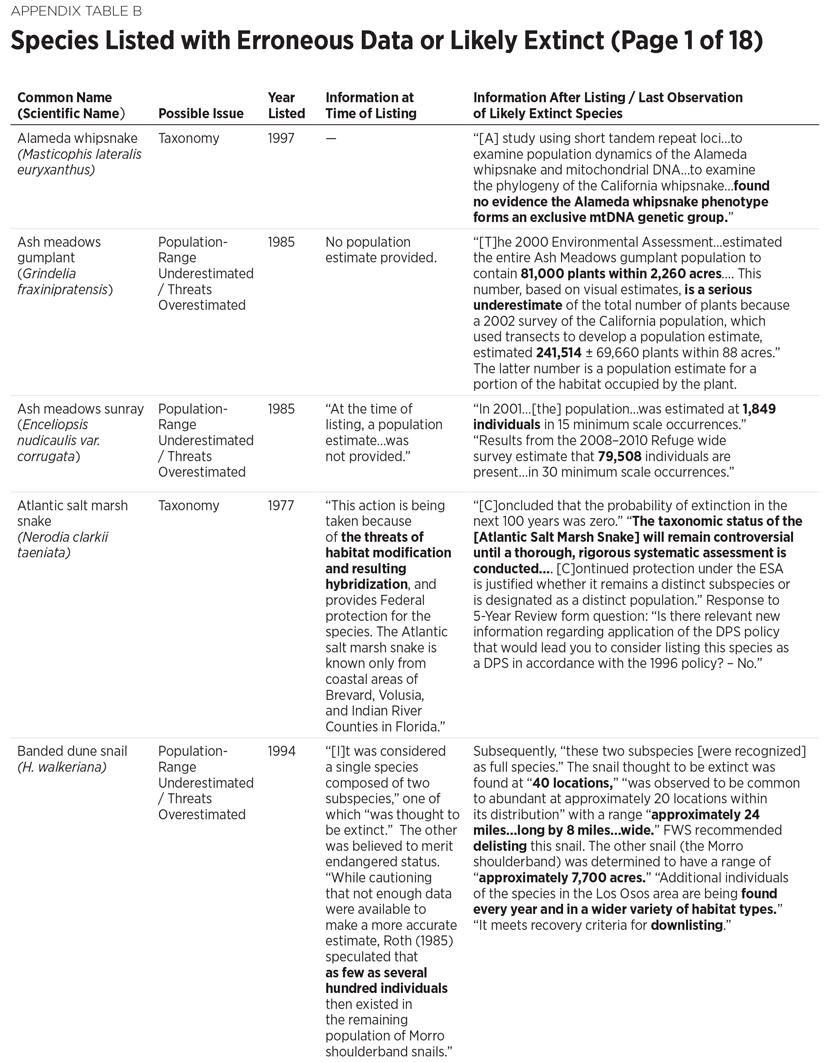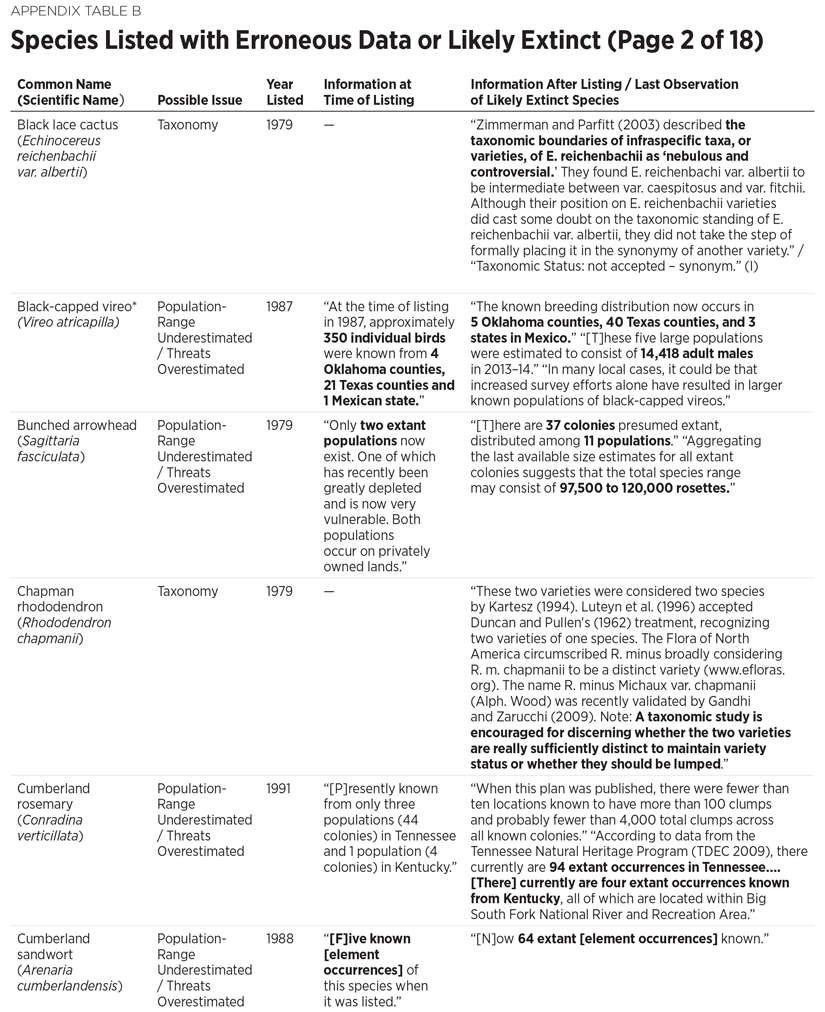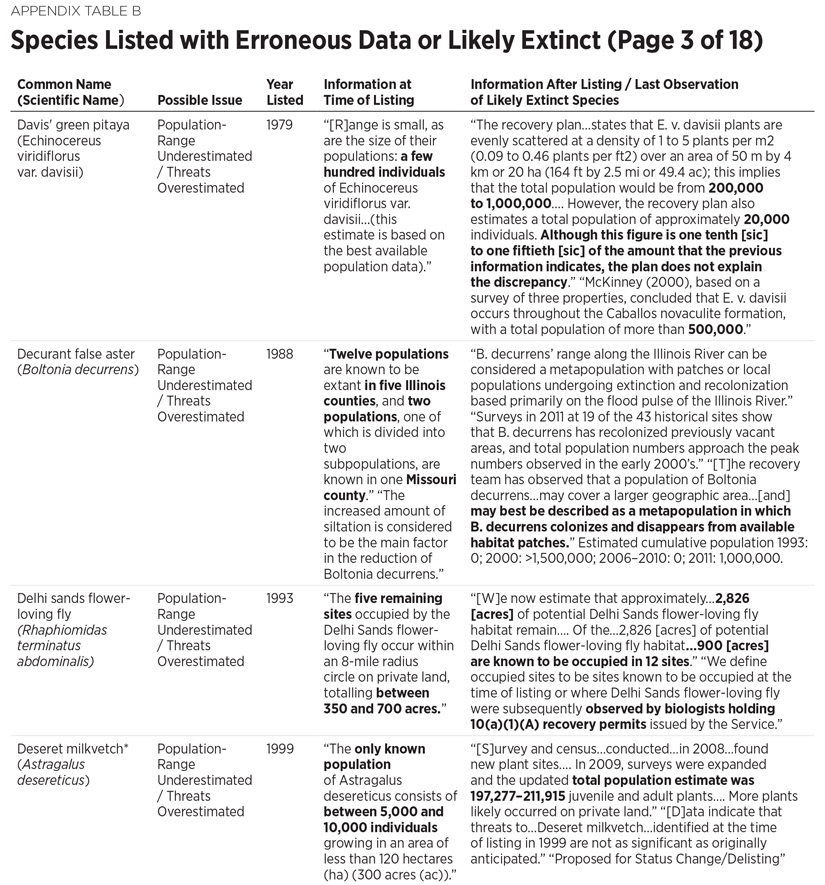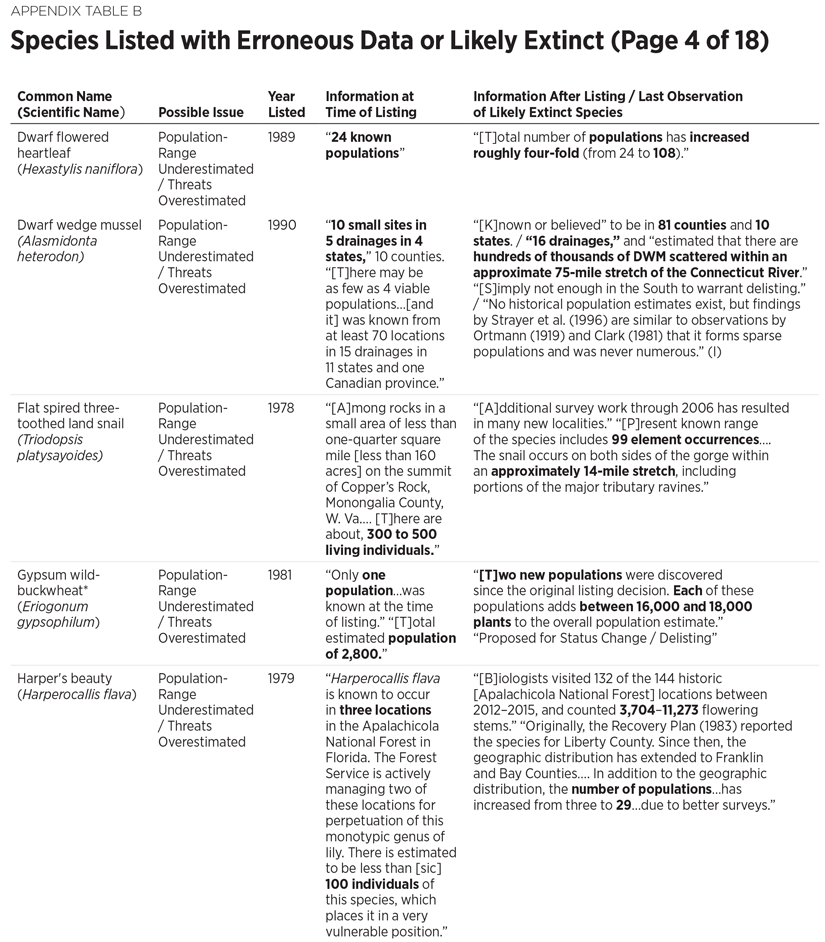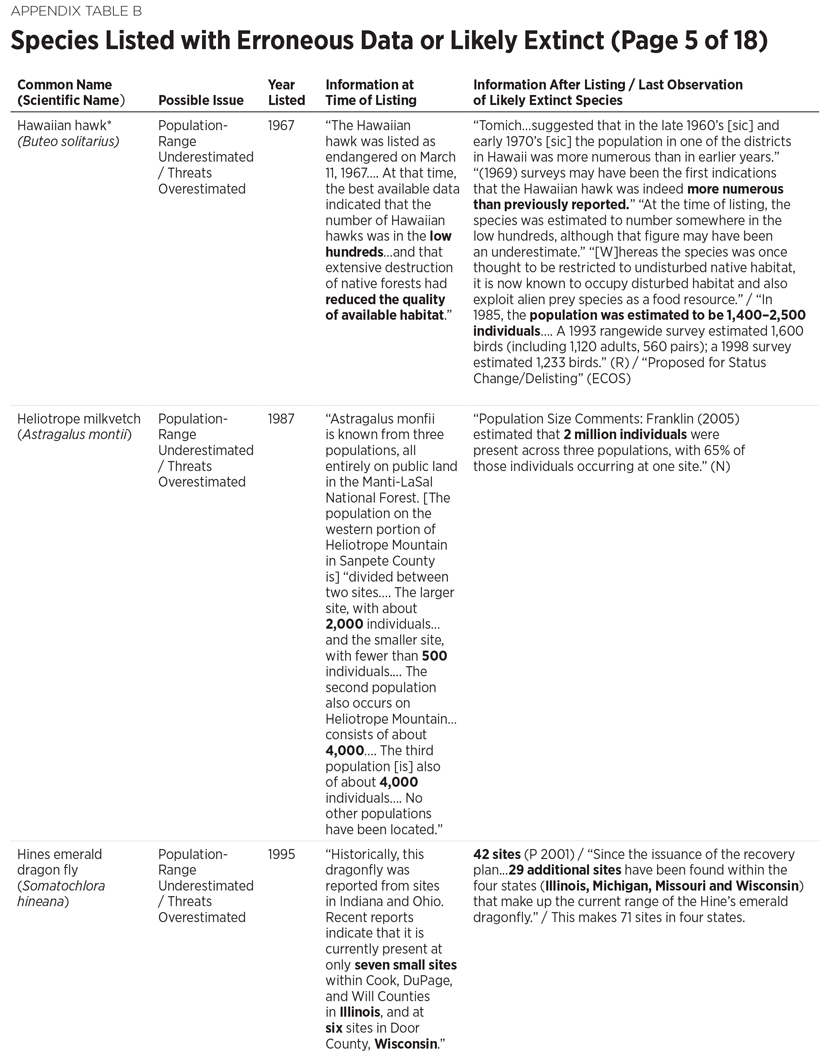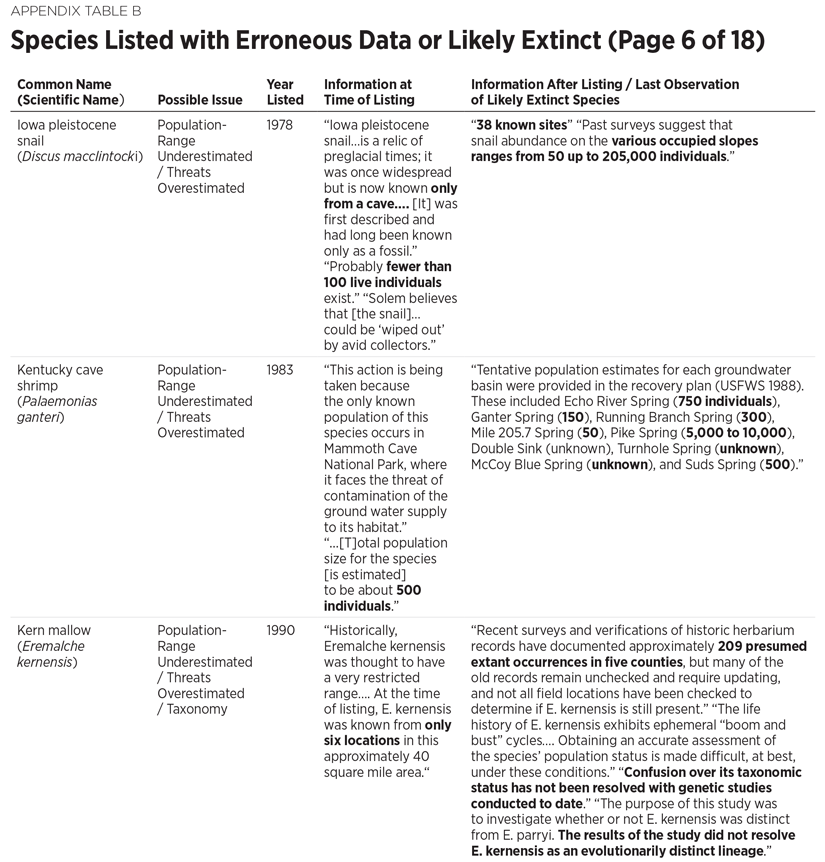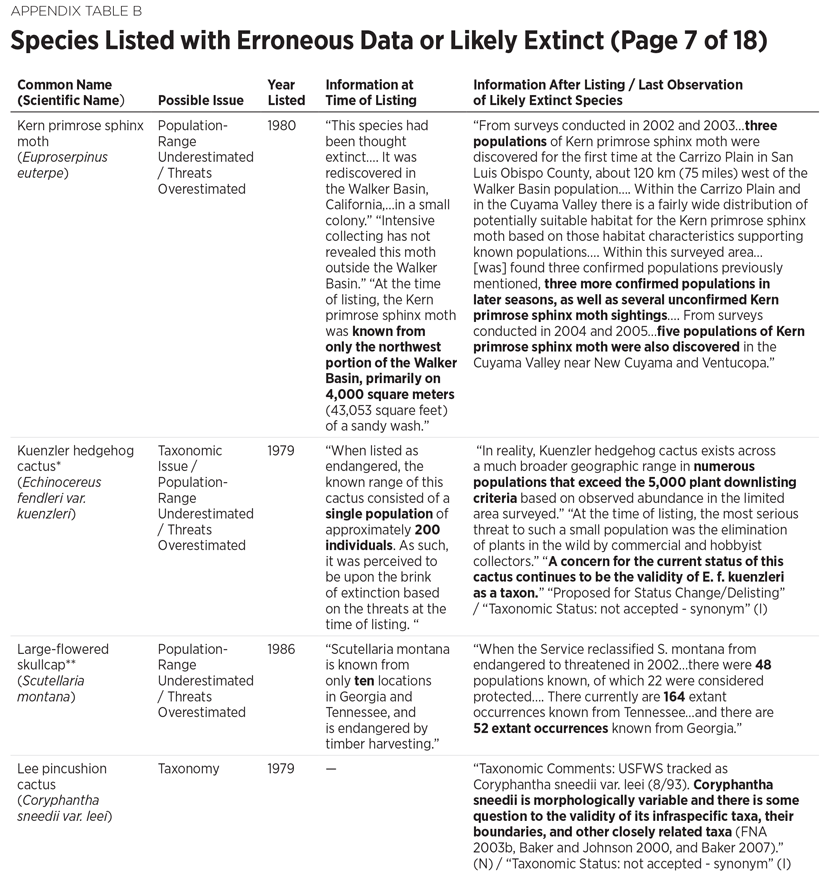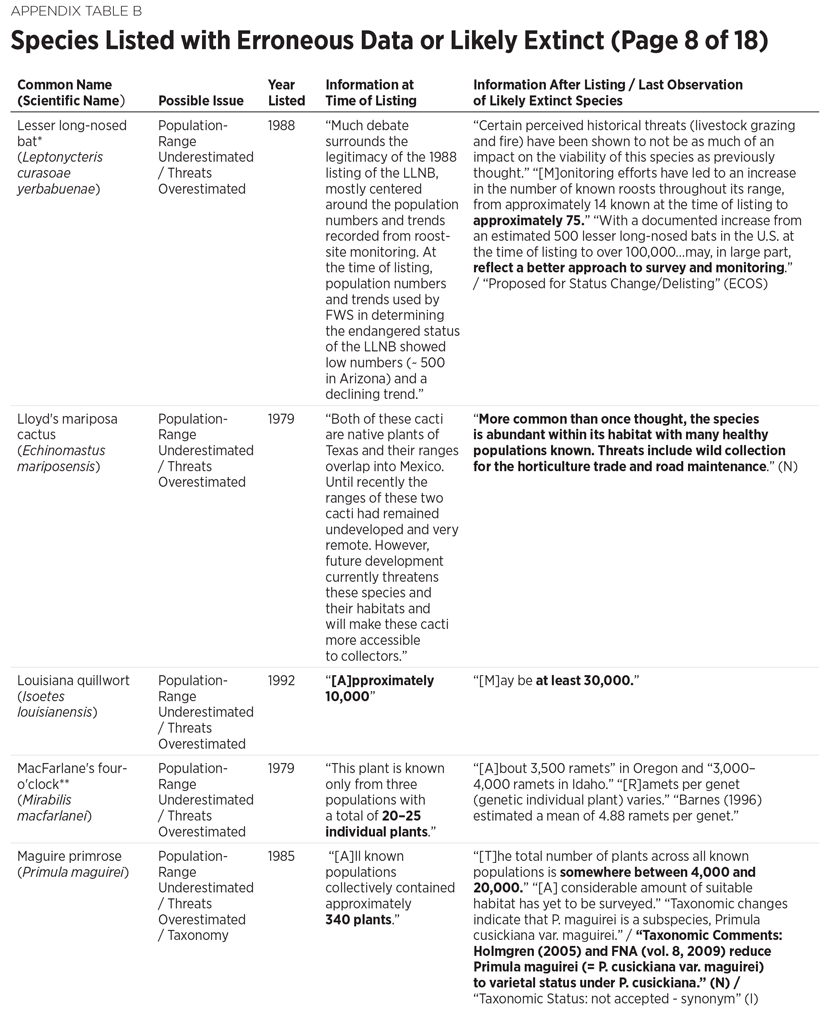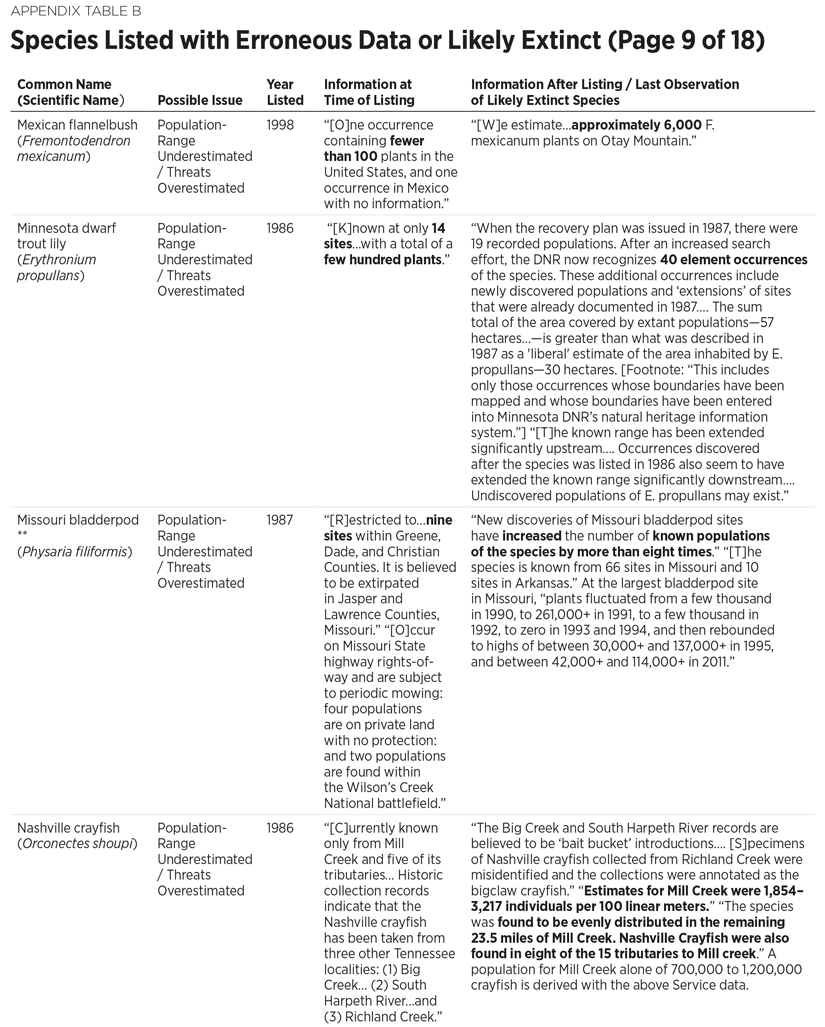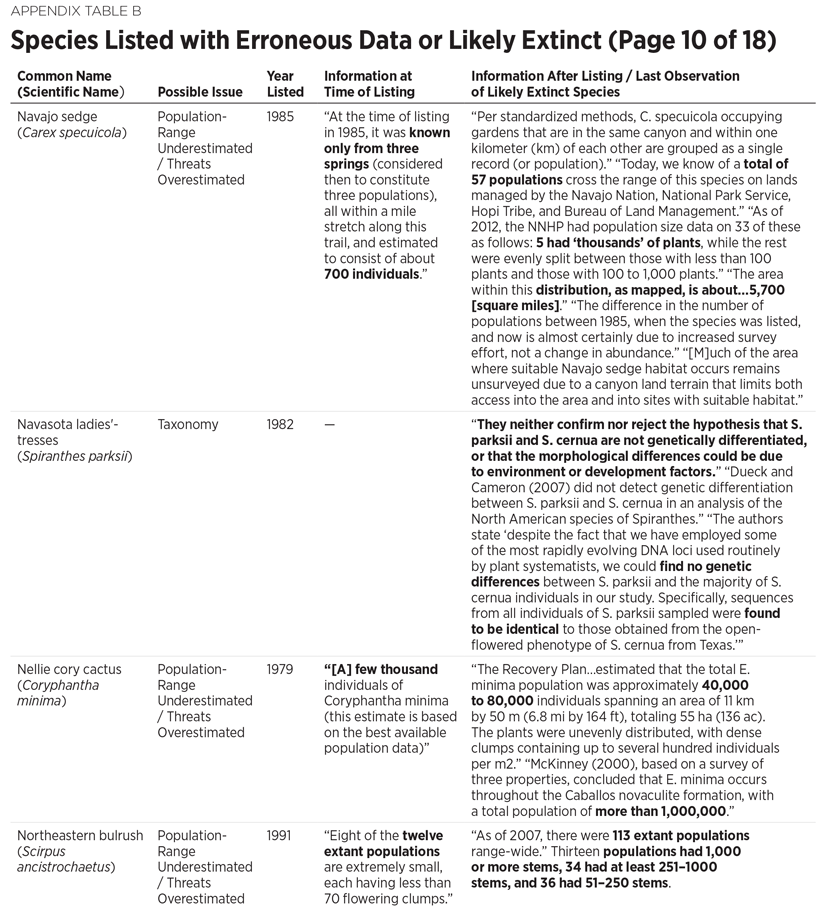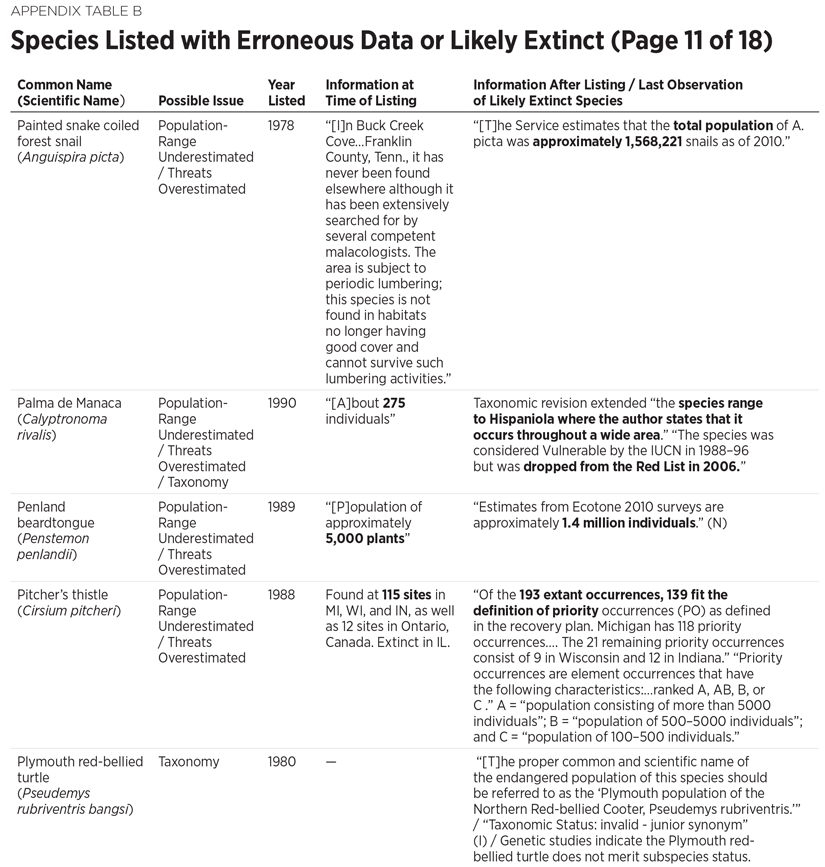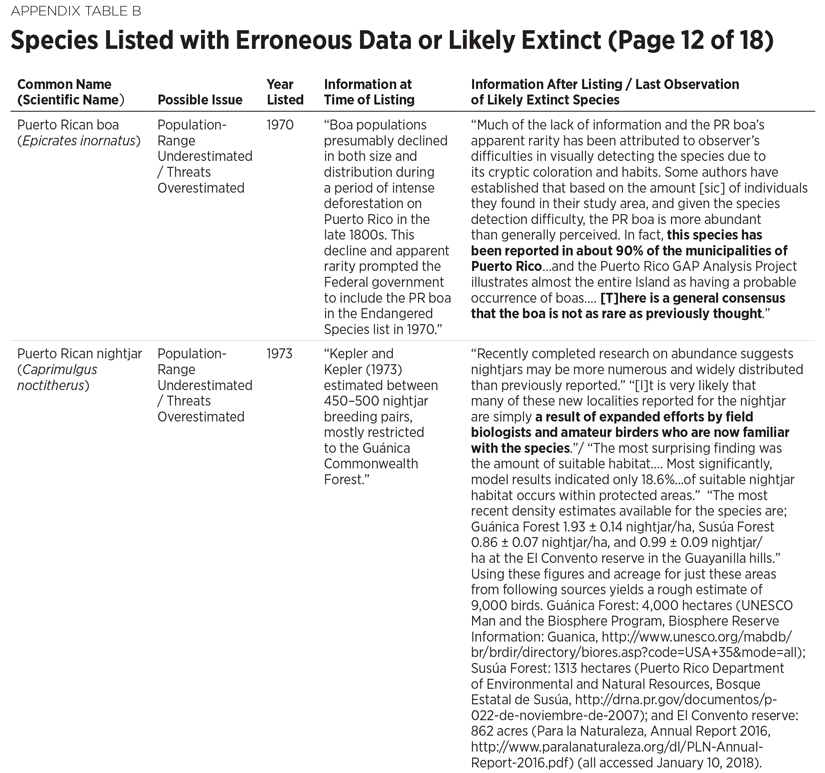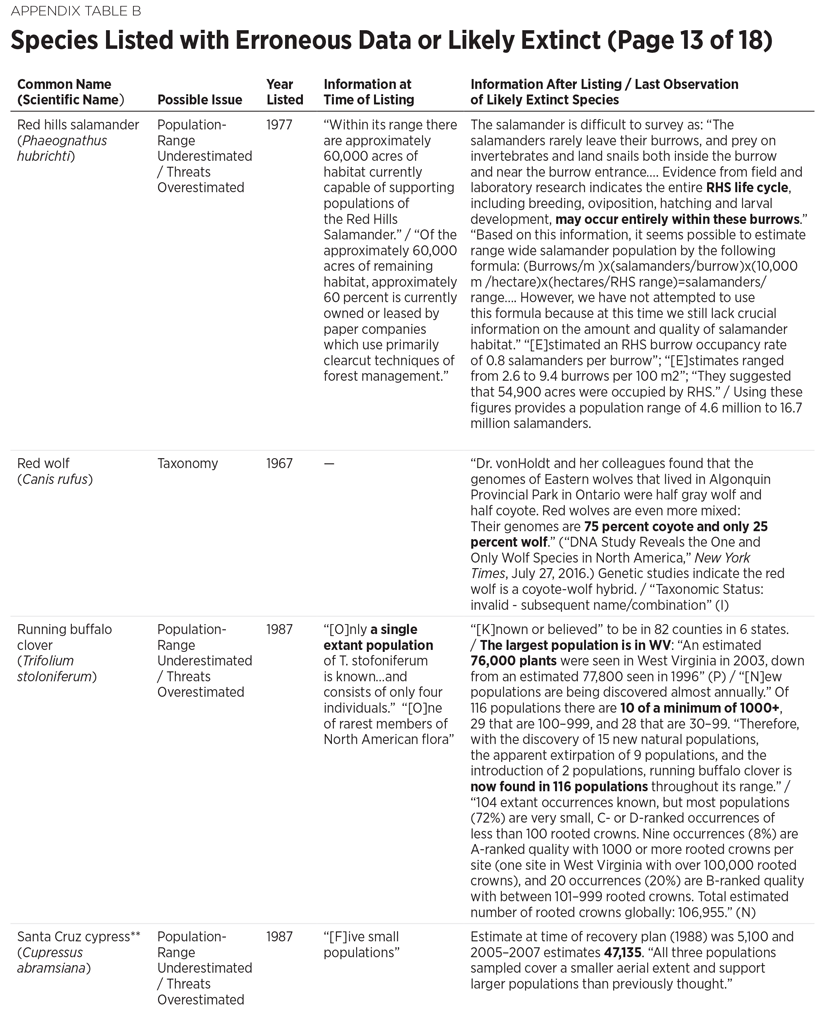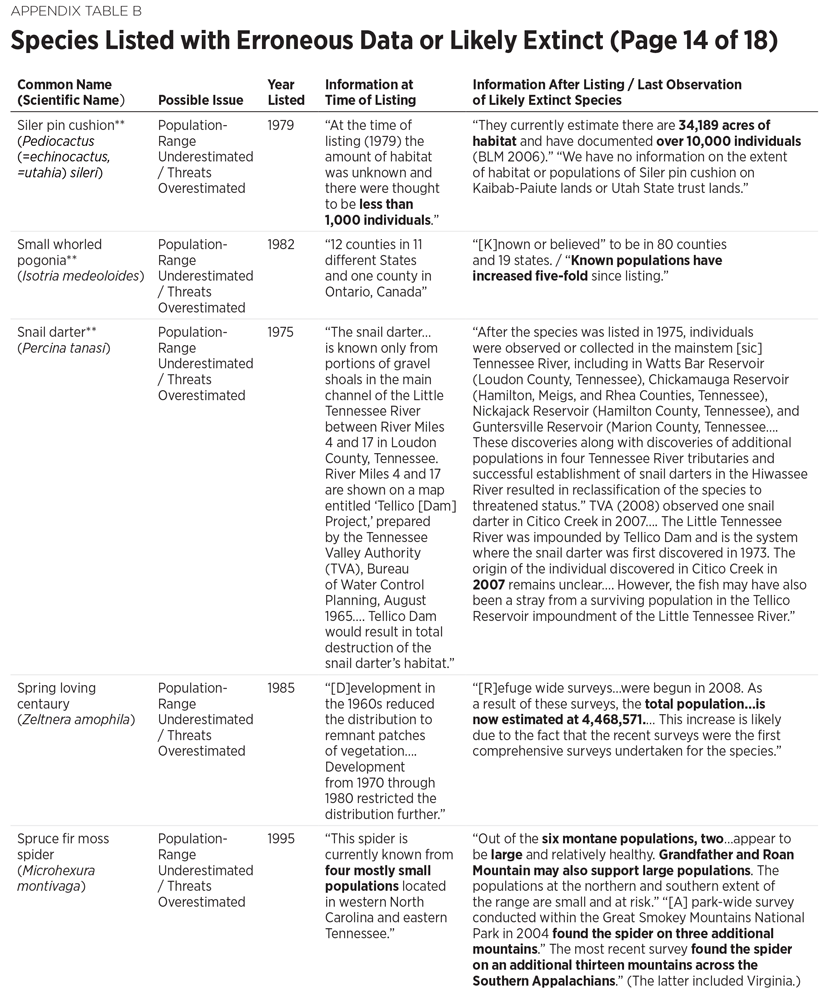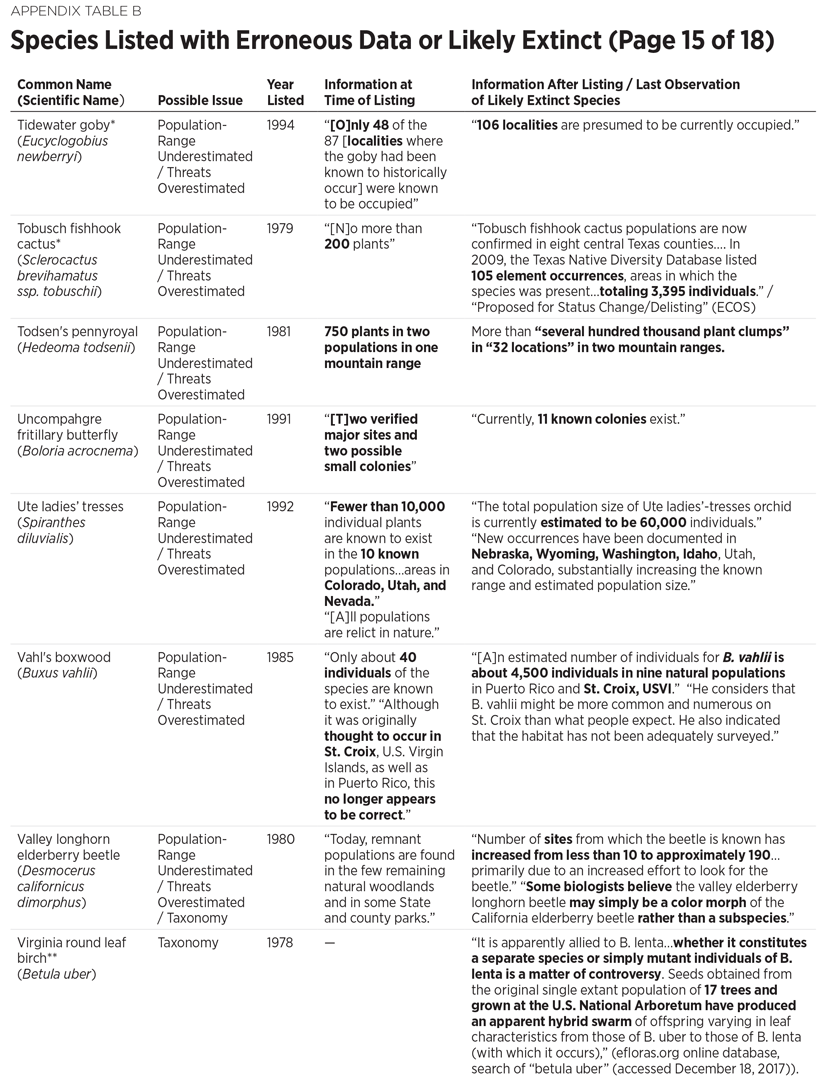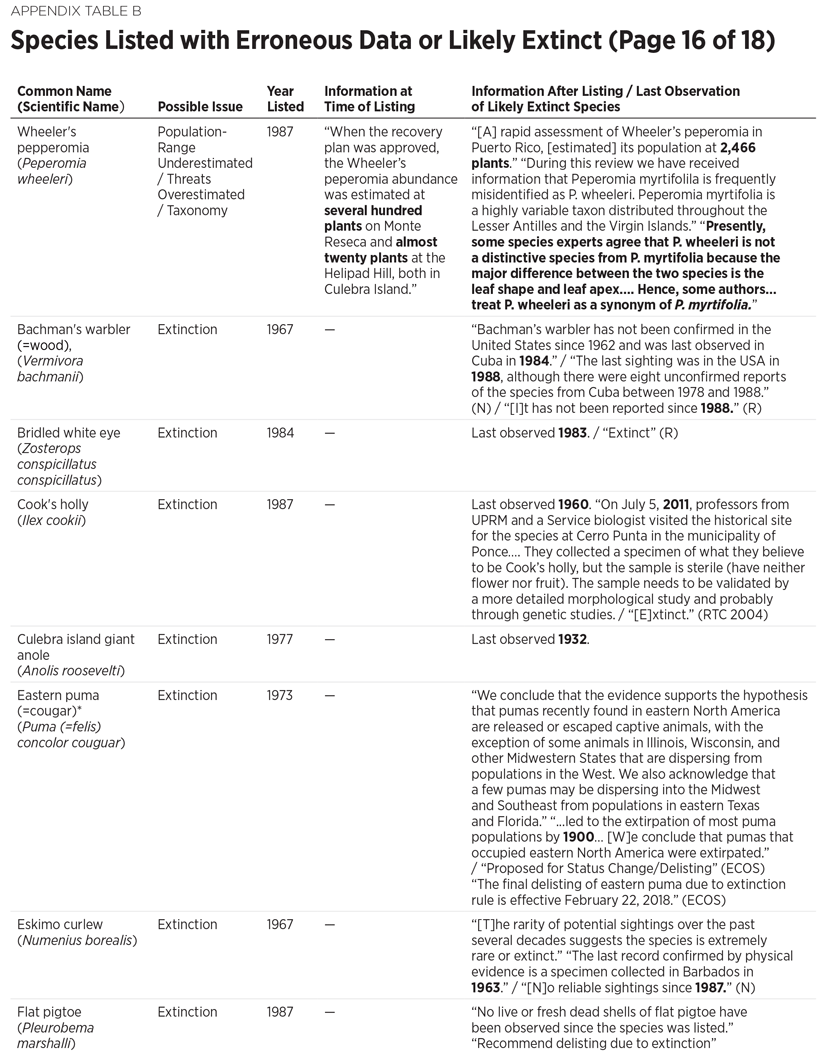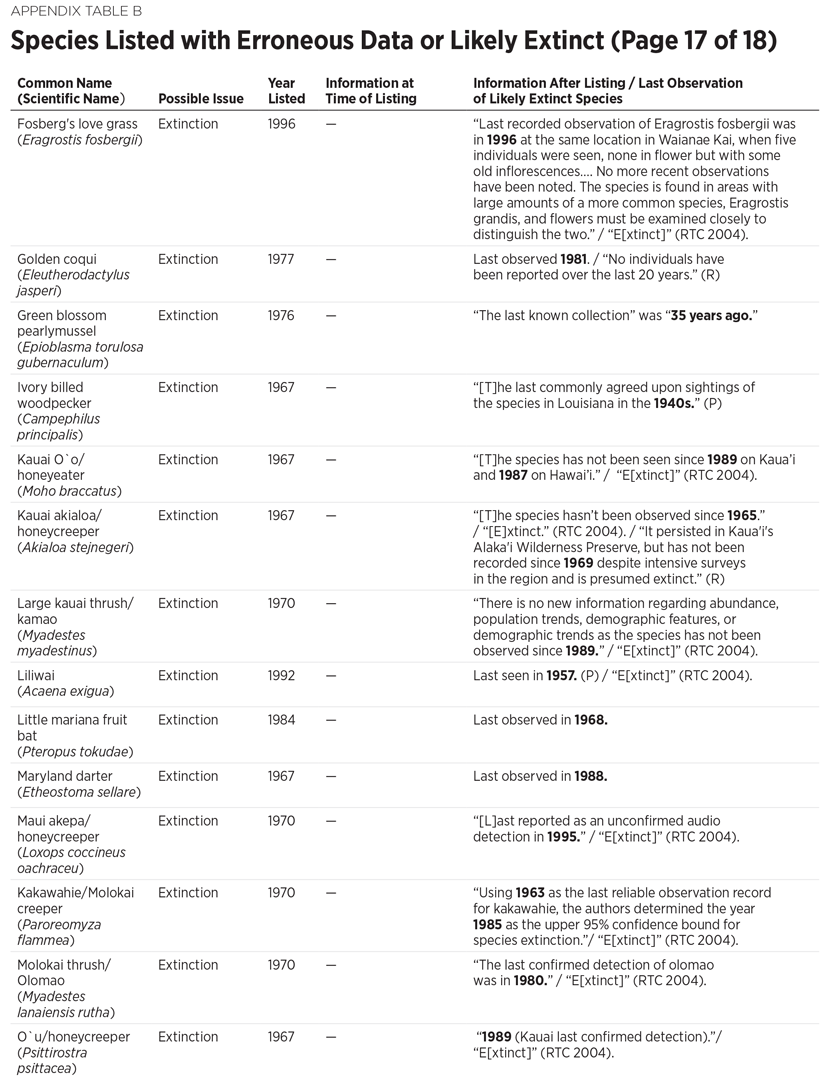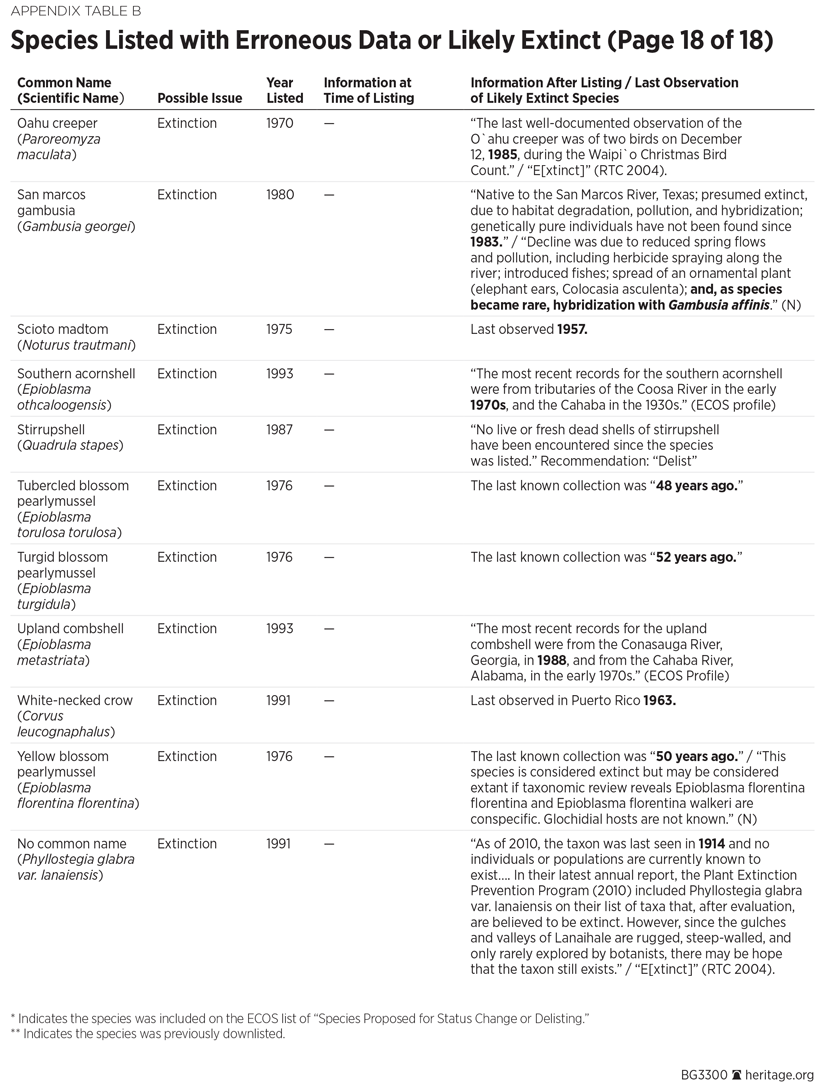Introduction
In five years the Endangered Species Act (ESA) will reach the half-century milestone—and yet only 40 U.S. species have graduated from the program as “recovered,” slightly less than one species per year. If not one more bird, beetle, or bear were added to the list of federally endangered animals and plants and somehow species recovered at 10 times that rate, it would take well over a century-and-a-half to work through the current list.REF There is, however, no indication that the list of regulated species will stop growing.
Even worse, almost half of the “recovered” species—18 of 40—are federally funded fiction. They were never really endangered; like many species that remain on the endangered list, they were mistakes. With all the ESA’s costs and burdens, it should perhaps come as no surprise that the U.S. Fish and Wildlife Service (hereafter “Service”) is fabricating success stories to cover up this unsustainable mess and substituting fluff for statutorily required reporting regarding the recovery program.
The ESA was ostensibly designed to conserve species threatened or endangered with extinction.REF When a species has been recovered that species is supposed to be removed from the list of federally threatened and endangered species (“list”) by a regulation citing “recovery” as the grounds for removal of the species (delisting). Species may also be delisted if it is determined that they are extinct or that the original data used to justify listing the species were in error.
The Service routinely falsely declares that a species that should have been delisted because of original data error has “recovered.” This deceitful practice portrays mistakes as successes, distorting the most important measure of the program. It also triggers other mandatory actions further wasting taxpayer dollars, serves as a justification for the adoption of more restrictive land management practices by other agencies, obscures significant problems with the data used to justify listing species, and erodes the overall credibility of both the Service and the program.
The Secretary of the Interior should administratively correct these false successes, appropriately identify the primary grounds for delisting these species as original data error, prioritize the delisting of wrongly listed and extinct species, and ensure that future delistings are attributed to the appropriate grounds. Any post-delisting monitoring efforts implemented for falsely recovered species should be terminated, and post-delisting special management regimes implemented by agencies such as the Bureau of Land Management (BLM) and U.S. Forest Service (USFS) for such species should be terminated as well.
Ultimately, measures need to be taken to raise the standards for data used in the designation of “threatened” and “endangered” species. Some actions that can be accomplished administratively are identified here. Additionally, the Secretary should return to incorporating meaningful data on the “status” of listed species into the biannual report to Congress that prior administrations stopped providing. Little meaningful data are now available for congressional oversight of recovery under the ESA. These and several other administrative reporting requirements could significantly improve accountability and transparency.
Background
Today there are some 2,340 species of which 1,661 are U.S. plants and animals on the federal list.REF Conservation under the ESA is defined as recovering a species to the point at which protections under the law are no longer necessary.REF When a species is recovered, it is to be delisted by a regulation that indicates the grounds for its delisting are recovery. Species may also be removed from the list if they are determined to be extinct or to have been originally added to the list using data that were in error.REF When a species is delisted it essentially completes the cycle established by the law.
False Recoveries
Some 81 species have been removed from the list since its inception.REF Of these, 13 were foreign species and will not be addressed here.REF Of the remaining 68 species that are or were found at least in part within the United States, 11 species have been removed from the list as having gone extinct and 19 have been removed from the list on the grounds of original data error.REF The remaining 38 species were officially removed from the list on the grounds that they “recovered.” Unfortunately, almost half of these “recoveries” are false.REF Many would be more accurately classified as “original data error” and likely include: Johnston’s frankenia, Modoc sucker, white-haired goldenrod, Louisiana black bear (delisted in 2016), Oregon chub (2015), island night lizard (2014), Virginia flying squirrel (2013), Concho water snake, Lake Erie water snake, Maguire daisy, Tennessee coneflower (2011), Eggert’s sunflower (2005), Tinian monarch (2004), Hoover’s wooly star, (2003), American alligator (1987), and the Palau dove, Palau owl, and Palau fantail flycatcher (1985).REF Additional information for some of these species can be found in Appendix A, Additional “Recovered” Species. Moreover, there are a substantial number of currently regulated species that were listed using erroneous data or are likely extinct. Many of these merit delisting or downlisting on the grounds of original data error. A table of 100 species that may fall into this group is included in Appendix B, Species Listed with Erroneous Data or Likely Extinct.
Examples of False Recoveries
Often the erroneous data used to list these species regard the estimated population or the extent of the species’ range. Such errors are commonly profound, often by an order of magnitude, off by a factor of 10, or even more. For example, when the Service listed Hoover’s wooly star, a plant, it provided speculative information about the plant’s numbers that indicated an already substantial population floor of over 35,000 to over 300,000 plants with “preliminary results” indicating an additional 28 populations.REF However, even that already large estimation was a gross undercount. After Hoover’s wooly star was listed, over 1,000 new sites were discovered with many falling within four meta-populations.REF While the plant’s numbers fluctuate, within the largest meta-population alone the Service reported the astounding approximation of 135 million plants.REF The Service omits this figure from the final rule delisting this species as “recovered” but does acknowledge: “Large areas of potential suitable habitat remain unsurveyed, and it is likely that additional sites remain undiscovered.”REF Seeking to obscure this error the Service states, “Research efforts, as part of the recovery process, have shown that Eriastrum hooveri is more resilient and less vulnerable than previously thought”REF(emphasis added).REF There was no recovery and so no “recovery process.” Instead, the bureaucratic process exposed the original listing as bogus.
Similarly, the Service included the Tinian monarch, a small bird found on the Pacific island of Tinian, on the endangered list, likely as a result of misinterpreting a decades-old observation of some 40 to 50 Tinian monarchs to be a population estimate for the entire island.REF Later, having determined there were tens of thousands of birds on the island and that the Tinian monarch was among the most abundant of birds there, the Service delisted the bird but attributed the delisting to recovery instead of the obvious cause of data error.REF
Sometimes the errors are an overestimated or completely incorrect assessment of a threat to a species. For example, when the Service included the Concho water snake on the list, it considered the primary threat to be the pending construction of a reservoir.REF The Service believed the reservoir would destroy the snake’s habitat. After the reservoir was constructed, the snake occupied it, and the Service also determined that the snake’s range was larger than previously believed.REF Subsequently, the Service hailed the Concho water snake as a success story, stating the snake had been threatened by “habitat modification and destruction,” but omits mention that concern about the reservoir was unfounded.REF
Similarly, Eggert’s sunflower, a plant found in Kentucky and Tennessee, was listed because of low numbers and a significant concern that many of 24 remaining populations were threatened by mowing and other routine roadside maintenance.REF Subsequently, Eggert’s sunflower discoveries brought the total to 287 sites in 27 counties, and the Service determined that the plants found along roadsides benefited from mowing.REF While never endangered, the Service reports evaluating the potential impacts from 262 federal actions upon the species.REF
Taxonomic error has also played a role in false recoveries. The Service announced the delisting of the Maguire daisy with a press release titled “[A]n Endangered Species Success Story,” stating that the “population of the daisy was known to number seven plants when it was listed as endangered in 1985 but now numbers 163,000 plants within 10 populations…. It is the 21st species to be delisted due to recovery.”REF The Service’s press release omitted that the daisy did not increase from seven to 163,000 plants. The larger number reflected more thorough surveys and the fact that the Maguire daisy and another plant that had been believed to be distinct were in fact the same species.REF
Post-Delisting Monitoring of Species That Were Never Really Endangered
When the Service declares a species recovered, it is required to monitor the species after taking it off the list.REF This requirement was intended to make sure species that had actually belonged on the endangered list did not slip back into an imperiled state, but it also applies to species falsely delisted as recovered. This would include, for example, Johnston’s frankenia, a plant found in a few southern Texas counties. The Service delisted the plant in 2016 and proclaimed it another ESA success.REF When the Service listed this plant in 1984, the agency reported it could only find about five populations totaling some 1,000 plants and expressed concern about “grazing pressure.”REF Subsequent surveys found over 4 million Johnston’s frankenia by one estimate—and over 9 million by another.REF While the estimate of 4 million plants was available by 1999, the plant was not delisted for more than a decade and a half.REF
When it finally delisted the plant, the Service provided a 28-page post-delisting monitoring plan that anticipates expenditures of $100,000 over nine years to conduct remote sensing at 20 sites and on-site assessments at nine sites.REF As explained in the Federal Register, the Service’s monitoring will make sure that threats, including “substantial human persecution,” do not cause the plant’s “relapse” into endangered status.REF
Unjustified “Post-Delisting” Management
Falsely proclaiming a species recovered also results in other agencies implementing a more restrictive post-delisting management for the species. For example, the BLM and USFS treat a species that was falsely delisted as “recovered” as a “sensitive species” in the agencies’ land and forest-management plans. When the Service delisted Hoover’s wooly star, which numbered in at least the tens of millions, it noted, “However, BLM intends to designate [Hoover’s wooly star] as a sensitive species and will continue to minimize impacts to the species at all known sites that are under its jurisdiction.”REF
Treatment of delisted species as sensitive species is required by the BLM’s policy manual that states that “[a]ll federally designated candidate species, proposed species, and delisted species in the 5 years following their delisting shall be conserved as Bureau sensitive species” (emphasis added).REF While BLM policy does not explicitly differentiate between species delisted due to recovery and those delisted due to data error or extinction, presumably the latter were not the intended focus. The BLM’s manual lays out numerous guidelines for sensitive species in land use planning, implementation-level management on BLM lands, and entering into “agreements, assessments, and cooperative conservation strategies with other agencies, organizations, governments, and interested parties.”REF Similarly, according to a Forest Service manual, a “species that is removed from listing under the ESA because recovery criteria have been met is automatically added to the sensitive species list for a period of at least 5 years to ensure that its recovery is maintained and monitored” (emphasis added).REF
Bureaucratic Costs
The process of listing species, designating critical habitat, preparing a recovery plan for the species, and the process of delisting the species all consume scarce conservation dollars. For example, the Service reported in 2014 that the “median cost for preparing and publishing a 90-day finding is $39,276; for a 12-month finding, $100,690; for a proposed rule with critical habitat, $345,000; and for a final listing rule with critical habitat, $305,000” (emphasis added).REF These are just the bureaucratic costs of listing species, whether they are legitimately endangered or threatened—or were listed on the basis of erroneous data.
One example is the Virginia northern flying squirrel. The Service listed the squirrel, one of 25 U.S. flying squirrel subspecies, reporting that it was possibly threatened by competition with the southern flying squirrel and forest clearing.REF The squirrel was considered extremely rare, discovered only as a result of 10 squirrels trapped in one Virginia and two West Virginia counties. When delisting the species as recovered more than two decades later, the Service stated that “its current range roughly approximates its historical range.”REF The “recovery,” however, was a fraud, as most of this range was not the area originally searched. After listing, it was determined that a majority of the squirrel’s range was actually in West Virginia. When surveys shifted into the squirrel’s actual range, despite the small mammal being incredibly difficult to capture, over a 1,000 were trapped at 109 different sites in eight counties, indicating a much more substantial population.REF The Service took the highly unusual step of adopting use of a new common name for the squirrel, the West Virginia northern flying squirrel.REF
Although the subspecies had never really been endangered, the Service’s website profile for the squirrel lists 13 Federal Register documents.REF The Federal Register printing costs alone are likely over $22,000.REF This does not include the costs to prepare these documents, as well as responses to litigation, a 62-page recovery plan and amendment, and a 70-page, five-year review and appendices.REF
Expenditures by Federal Agencies
Other costs of species listing errors can be much larger. The Oregon chub, a minnow endemic to the Willamette River Drainage in Oregon, is a good example. When the fish was listed in 1993, only nine populations were known to exist, and it was believed to only inhabit 2 percent of its former range. After listing, enough new populations were discovered that the fish was downlisted from endangered to threatened. Subsequently, another 34 populations were discovered,REFand the Service eventually proclaimed the fish recovered.REF While the fish was listed for over two decades, between 2005 and 2014 alone the Service reports over $13 million in expenditures by 11 agencies and states including over $10,000,000 by the Department of Energy, $400,000 by U.S. Department of Agriculture, $300,000 by the Army Corps of Engineers, and $90,000 by the Department of Transportation.REF
These figures are drawn from the annual species-by-species expenditure report required by the ESA and produced by the Service.REF The most recent report (fiscal year 2015) indicates 31 federal government entities and states reported spending $1.507 billion on listed species.REF This figure is clearly an underestimate as, for example, the USFS reported spending only $1.12 million and all of it dedicated to a single species.REF This is implausible, as the prior year’s report indicated USFS spent $45,983,888 on over 150 different species.REF Additionally, these reports exclude all litigation costs. The lump sum expenditures for states are also clearly unreported, as several states are not included. For example, in the most recent report, 21 states, including California—one of the most heavily impacted states, if not the most—failed to report, as well many other states with likely significant expenditures, such as Georgia, Hawaii, Idaho, Kansas, Mississippi, New Mexico, South Carolina, Tennessee, and Texas.REF
Economic Impact and Regulatory Burden
Even if a species should never have been listed, while it is listed, landowners or businesses whose actions might unintentionally harm a member are potentially subject to the ESA’s fines and penalties. The Service can impose expensive—and even absurd—burdens on private property owners and businesses seeking immunity from potential civil and criminal liability under the ESA. The restrictions the Service sought to impose on behalf of the Lake Erie water snake are a good example.
The Lake Erie water snake is a subspecies of the abundant and widely distributed northern water snake. The most substantial differences are that the Lake Erie snakes are found on several islands in Lake Erie and differentiated primarily by having faded or altogether absent markings. The snake’s population was estimated to be only 1,530 to 2,030 adults when it was listed in 1999.REF These snakes take several years to reach sexual maturity, and in their first year of life have a low survival rate. Nonetheless, within just a few years of listing, the adult snake population was estimated to be 5,690, which, if correct, reveals either a truly miraculous population growth rate or a substantial underestimation at the time of listing.REF
Although the snake’s population was large enough to meet the recovery plan’s overall target right after listing, it did not meet the plan’s required population number for one of several islands. Additionally, the population targets had to be met or exceeded for a number of consecutive years before the snake would be delisted.REF Service documents reveal surreal regulatory hurdles faced by a developer seeking to build seven homes on 15 acres during this time.
The Service sought easements on over five acres of lakefront property (to be donated to a nonprofit organization); the donation of $50,000 in in-kind contributions, including the construction of two snake hibernacula (dens where snakes hibernate) on each of seven residential properties; and the establishment of a homeowner’s association to impose even more restrictions.REF The list of homeowner’s association’s restrictions included ensuring no snake be within 20 feet when applying weed killer to poison ivy, not allowing cats outside, abiding by seasonal height and temperature restrictions for mowing, collectively providing up to $18,750 for snake research, and allowing researchers (possibly including those whose likely low population estimates were used to list the snake) to access the properties.REF This is a small example of the heavy-handed regulatory process for just one of the nearly 1,700 listed species to which landowners and businesses are repeatedly subject across the nation.
Economic analysis conducted by the Service for designation of critical habitat for the Louisiana black bear provides a glimpse into costs on a larger scale. The bear is putatively a subspecies of the black bear, Ursus americanus, which itself is the most common of all bears. In fact, there are likely more black bears (near 1 million) than all bears of all other species combined, and the species is found in 46 of 50 states.REF The Service declared the Louisiana black bear endangered in significant part because of threats from loss and fragmentation of its habitat, including from forestry.REF The Service had particular concerns regarding the loss and promulgated a special rule to protect “actual and candidate” denning trees.REF However, when the Service declared the Louisiana black bear recovered it acknowledged that “the availability of den trees does not appear to be a limiting factor in reproductive success as bears demonstrate flexibility in den use,” and that nests were “located in thick vegetation, usually in areas logged within the past 1 to 5 years…and are typically found within felled tops and other logging slash” (emphasis added).REF
As the International Union for the Conservation of Nature (IUCN) notes, the “validity and integrity of this subspecies has been debated.”REF Ironically, the IUCN also states that the Service’s conservation activities “linked a population that was believed to be native Louisiana black bears with a population that had previously been established by translocating [a different subspecies of] bears from Minnesota.”REF The IUCN notes that if the Louisiana black bear merits subspecies status, “the successful establishment of a conservation corridor reduced the purity of that genetic stock.”REF Additionally, non-Louisiana black bears from Arkansas wandered into the habitat of and interbred with Louisiana black bears.REF The Service provides no overall population estimate for the black bear in its delisting, but from the convoluted data that are included, the population appears to be small. The Service’s decision to delist this “subspecies” might be best explained by the compelling evidence indicating that the bear does not really merit subspecies status, including extensive genetic studies published the same year as the proposal to delist the “subspecies.”REF Nonetheless, when designating critical habitat, the Service estimated the economic impact of Louisiana black bear conservation efforts to range from $165.7 million to $202.9 million.REF
False Recoveries Indicative of a Larger Problem
The many species wrongly delisted as “recovered” are indicative of a larger problem. The standards used in determining species to be endangered or threatened present a low bar. Consequently, while the prevalence of data error is unknown, it is clear there are many species that remain on the endangered list that should have never been listed. Appendix B provides information for 100 listed species that were or may have been erroneously listed but remain regulated under the ESA as well as a number that are possibly extinct. The possibly extinct species are included because this information is no longer reported (as was previously done in biannual reports to Congress, which is addressed later). Many of these species should be delisted based on data error or extinction.
When the Service listed the Iowa Pleistocene snail, one of the Appendix B species, there were concerns that it “could be ‘wiped out’ by avid collectors,” as it was estimated that “probably fewer than 100 live individuals exist” at a single site.REF There are now reportedly “38 known sites,” and the most recent 5-Year Review states that “surveys suggest that snail abundance on the various occupied slopes ranges from 50 up to 205,000 individuals.”REF This vast undercounting will hopefully suffice as a basis to delist the species as otherwise the snail’s recovery plan indicates a long-term program stating: “With a return to glacial conditions [the snail] will be resuscitated over a major part of the upper Midwest, provided its relictual areas are preserved and maintained” (emphasis added).REF
Similarly, the running buffalo clover was described as “one of rarest members of North American flora” at the time of listing, with reportedly only 22 plants at two sites in one state.REF One of the sites having 18 plants had been mowed, so the status of those plants was uncertain.REF Since that time, better data have revealed 116 populations in 83 counties in seven states, that “new populations are being discovered almost annually,” and that one West Virginia population alone has been estimated as high as 77,800 plants.REF
Other currently listed “endangered” or “threatened” species have been determined to have similarly large numbers, such as the Nashville crayfish (with roughly 700,000 to 1,200,000 individuals in part of its range);REF the painted snake coiled forest snail (at 1,568,221);REF and the spring loving centaury, a plant (at 4,468,571).REF
Other “endangered” or “threatened” species are not species at all but rather taxonomic errors, such as the red wolf, which actually is a coyote–wolf hybrid.REF Annual expenditure reports show that the Service, other federal agencies, and states spent over $27,000,000 on the red wolf between 1996 and 2014.REF This does not include economic impact, any funds expended by private groups, or any federal or state tax dollars spent in the almost three decades the wolf was listed between 1967 (under a predecessor law) and 1995.
Report to Congress
In addition to fabricating recovery successes, the Service has substituted nearly useless data for the recovery measurements “status” and “recovery objective achieved” that were previously provided in the statutorily required biannual report to Congress on the recovery program.REF The status and recovery objective achieved measurements were the only uniform non-anecdotal measurements collected that shed light on whether the ESA effectively conserves species.
The “status” measure has the possible values of “improving,” “stable,” “declining,” “unknown,” and “extinct.” The final time species “status” was reported, 158 or almost 12 percent of listed species were claimed to be “improving.”REF This was an unexplained and extraordinary increase from just two years before when only 91 species were “improving.”REF However this occurred, it seems unlikely that a federal agency would cease reporting data that earnestly reflected favorably on the program. Additionally, upon examination, a number of these species owe this assessment, at least in part, to the discovery of erroneous data, species such as the Concho water snake, desert milkvetch, Oregon chub, palma de manaca, and Ute ladies’-tresses—all species addressed here or in Appendix B.
The Service also quit reporting a measurement known as “recovery objective achieved” after the 2005–2006 report. This is a percentage-based measurement that assigned each species a value indicating that 0 percent–25 percent, 26 percent–50 percent, 51 percent–75 percent, or 76 percent–100 percent of recovery had been achieved. The last year these data were reported, just over 2 percent of species fell in the 76 percent–100 percent range.REF Among these were many species addressed here or in Appendix B such as Johnston’s Frankenia, the Magure daisy, and the Virginia northern flying squirrel.REF
In place of these measurements the Service now provides a number of less informative measurements, including the date a recovery plan was produced; whether the plan is final, a draft, or in revision; “number of actions implemented”; “estimated cost to recovery”; “estimated years to recover”; and the date of the last statutorily required five-year review for a species and the review’s recommendation. Most of these are of little use.
The “number of actions implemented” is the total number of recovery actions identified in the implementation schedules of recovery documents that are considered completed. For example, two of the first species listed in the 2013–2014 report, the golden coqui (a frog) and the California red-legged frog, are reported to have 3 and 38 recovery actions implemented, respectively.REF These, however, are the same numbers reported in two prior reports and somehow decreased since the fiscal years 2007–2008 report that indicated 6 recovery actions and 104 recovery actions had been completed, respectively.REF Further, if a reader did not know to check prior years’ reports that included the status measurement, it would not be evident that the Service believes, or previously believed, that the golden coqui is extinct.REF Moreover, given that implementation schedules come from recovery planning documents that differ dramatically from species to species, the raw numbers are nearly if not entirely useless for comparison.
“Estimated cost to recovery” and “estimated years to recover” are likewise drawn from recovery plans or other similar documents. Recovery plans are not regulatory documents, and consequently these numbers are just estimates that have no force and are often incomplete, vague, or lacking altogether. Of the first page of species listed in the 2013–2014 report, 17 of 24 have no estimated recovery cost and no estimated time to recovery.REF
The five-year review status recommendation is useful data. However, the data is collected every five years at best. By far the most common data provided for this field in the biannual report is “no change to listed status”—as is the case for the presumed-extinct golden coqui.REF
Recommendations
Numerous administrative actions can be taken to address the false record created by the Service and to improve accountability and transparency in the administration of the ESA.
False Recoveries
- The Secretary should issue an order directing the Service to accurately identify the data that form the basis for removing or downlisting a species. The order could include other elements from those suggested below as part of a broader accountability and transparency effort.
- The Service should correct the record by identifying and revising the basis of delisting for those species that the Service has wrongly declared to have recovered. Those species for which removal from the list was wrongly attributed to recovery and that have been delisted for more than five years are beyond the statute’s requirement for post-delisting monitoring. As there is unlikely to be regulatory impact from issuing regulations correcting the basis for delisting these species, notice and comment may be unnecessary and corrections could be effective upon publication.
- Scarce conservation funds should be redirected from post-delisting monitoring for species falsely claimed to have been recovered.
- The BLM, USFS, and other land-managing agencies should no longer identify species that were in reality removed from the list on the basis of data error as species of special concern—and should redirect conservation expenditures and actions to those species legitimately on the list.
Listing and Delisting Species
- The Secretary should direct the Service to aggressively pursue the delisting of species listed using erroneous data or that are extinct.
- When delisting a species because the species has been found to be more numerous, have a greater range, face less severe threats than believed at the time of listing, or be taxonomically ineligible, the species should be delisted on the basis of original data error. This ensures that conservation dollars are spent where most needed. Similarly, when downlisting a species from endangered to threatened, a regulation should acknowledge any original data error, establishing an accurate record for subsequent administrative actions. Delisting these species could help comply with the Executive Order on Reducing Regulation and Controlling Regulatory Costs.REF
- In the listing process, the Secretary should require: (1) a clear, concise, and enumerated summation of each five-factor threat with relative weighting and related population-level effects for each five-factor threat and the Service’s confidence in this data; and (2) a clear summation of the known population and distribution of the species at the time of listing with as much numerical specificity as available (i.e., number of animals, populations, acres inhabited) and the Service’s confidence in this data.
- All data used or relied upon in a listing decision should be publicly available prior to the proposed or final action.
Recovery and Expenditure Reports
- The measurements “status” and “recovery objective achieved” should be included in biannual reports to Congress.REF If data were collected for previous years but not published, supplemental reports should be issued so that the data gaps may be filled to the extent possible.
- Litigation costs should be included in annual expenditure reports, including attorney’s fees, as such expenditures are made by agencies following the ESA’s requirement to “utilize their authorities in furtherance of the purposes of this Act by carrying out programs for the conservation of endangered species and threatened species.”REF Litigation expenses should be reported by agency and by species—but separately from general expenditures so as to make figures across years more comparable. Data should be requested both from the Department of Justice and the Department of the Treasury.
- The expenditure report should separately list any ESA Section 6 grant monies going to states that fail to report any expenditures. In a listing of each state’s total expenditures, those states that did not report any expenditures should be identified. Failure to report expenditures should be taken into consideration in subsequent year’s grant-making decisions.
- Letters transmitted by a reporting agency or state addressing the data provided for an annual species expenditure report should be included within the report. Such letters can provide valuable information regarding implementation of the program, particularly costs borne by an agency or state that may somehow fall outside the reporting parameters. Such correspondence was included in prior reports. Additionally, the Service could request that states gather economic impact data from counties or other political subdivisions and incorporate this separately.
- The Service should include data in expenditure reports on the value of land or interests therein (i.e., easements) that flow to third parties as a result of implementation of ESA regulatory or enforcement actions. While these are not expenditures, the Service reports land purchases separately in expenditure reports. The value of mitigation lands or easements or other such instruments that are purchased from, donated to, or otherwise transferred to nongovernmental organizations or other third parties as a result of a regulatory or enforcement action are essentially off the books. This information should be reported separately from land purchases and general expenditures—and should be reported by agency and by species.
- The Service and National Marine Fisheries Service should include in expenditure reports all funds, the value of real property or interests therein, and the value of in-kind services the agencies received as a result of regulatory or enforcement action. This information should be reported separately from land purchases and general expenditures and should be reported by species.
- The Department should produce a separate baseline report on the total acreage of mitigation lands, easements, or similar instruments that have been transferred as a condition of obtaining an incidental take permit or as a result of regulatory or enforcement actions taken under the ESA or other laws. This should list acreage by state and county and identify the new owner. The U.S. Geological Survey may be an additional repository of knowledge and data regarding these lands through its National Gap Analysis Protected Areas Database and its collaboration regarding data acquisition and standards with the National Conservation Easement Database.
- The Service should report annually on the acreage of all mitigation lands or interests in property such as easements or similar instruments that have been transferred to the Service or another entity as a term or condition of a Habitat Conservation Plan or other regulatory or enforcement action taken under the ESA or other laws.
Conclusion
The Endangered Species Act is not only costly but also has been so ineffective in reaching the ultimate goal of recovery that the Service has spent taxpayer dollars to fabricate a record of success.
It is not uncommon for doctors to misdiagnose patients. However, were a doctor to routinely claim he had cured patients whom he had misdiagnosed as “terminal,” there would be consequences. If, for example, undercounting the plant Hoover’s wooly star by more than 135 million does not qualify as “original data error,” what would? The practice of falsely declaring species recovered increased dramatically during the Obama Administration, leading to headlines such as Scientific American’s “U.S. Endangered Species Recovery Surges to Record High.”REF Proclaiming mistakes as success presents an inaccurate picture of the ESA and obscures other problems.
Species have previously been appropriately delisted on the basis of data error—as was the case with 19 species including the Dismal Swamp shrew, Tumamoc globeberry, and Pine Barrens tree frog.REF When a species’ population or range was underestimated, a taxonomic classification was invalid, or threats were overestimated so that a species that would not have been listed was listed, the species should be delisted on the grounds that the original data were in error. This remains true even if the Service undertook activities that increased our knowledge of or directly benefitted the species. Failure to correct these false recoveries is an implicit acknowledgement of willful dishonesty.
Many currently listed species should be delisted on the grounds of data error—such as the red wolf, flat-spired three-toothed land snail, Hawaiian hawk, spruce fir moss spider, Todsen’s pennyroyal, running buffalo clover, and black lace cactus. While over 50 species that were listed using erroneous data are identified in Appendix B, this list is by no means exhaustive. All of these species were listed prior to the year 2000—before several “mega-petitions” (petitions to list hundreds of species) hit—and there is little reason to believe later listings are more reliable.REF
The recommendations and information here would help correct the record; provide guidance as to some of the species that should be delisted on the grounds of data error as well as extinction; improve the likelihood that future delistings are appropriately categorized; and improve accountability and transparency.
Many of these errors are attributable to the low bar for scientific data used to list species, the ESA’s litigation-driven construct, and possibly a bureaucracy as interested in accumulating authority as in conservation. The law calls for the “best available scientific and commercial data” to be used in listing species. Unfortunately, the manner in which the Service has interpreted this directive does not require the data to be accurate, reliable or even sufficient to reach a scientific conclusion. In short, the “best available data” are often of poor quality—and sometimes not even made available to the public before listing. While some of the recommendations made here would improve the situation, this is a far larger problem that gets into the language of the ESA itself. The first steps, however, are acknowledging the seriousness of the problem, correcting the record, and ensuring it does not continue.
—Robert Gordon is a Visiting Senior Research Fellow in Regulatory Policy in the Thomas A. Roe Institute for Economic Policy Studies, of the Institute for Economic Freedom, at The Heritage Foundation.
Appendix A: Additional “Recovered” Species
American Alligator. The alligator was first listed under a law that preceded the ESA and was included among those species first regulated under the Act when it became law on December 28, 1973.REF The Service delisted the alligator as a “recovered” species in 1987.REF Writing for the National Wildlife Federation, T. A. Lewis recognized that same year that the “familiar and gratifying” recovery story of the alligator was “mostly wrong.”REF By July of 1975, when the ESA had been law for only one-and-a-half years, the Service reported “that significant losses of populations have occurred only in geographically peripheral and possibly ecologically-marginal areas. Population levels in parts of South Carolina, Georgia, Florida, Louisiana, and Texas are high, and, in many areas over these regions are considered to be ecologically secure” (emphasis added).REF Reportedly, “[b]y 1975, the Florida Game and Fresh Water Fish Commission was responding to about 5,000 complaints per year involving ‘nuisance’ alligators that had ventured too close to humans, and it was relocating about 2,000 of them.”REF In 1979, the Service contacted the expert who had provided earlier population estimates and reported that “his original 1965 estimate of 35,000–46,600 animals within [Louisiana] was extremely conservative, and that ‘a more realistic estimate of the 1966 statewide population would be about 100,000 animals.’”REF
Island Night Lizard. The Service delisted the lizard as “recovered” in 2014REF after having listed it as threatened in 1977.REF The lizard is endemic to several California Channel Islands including San Clemente Island (SCI) and San Nicholas Island (SNI), which are maintained by the Navy, and Santa Barbara Island (SBI), which is maintained by the National Park Service.REF The Service saw the primary threat to the lizard as stemming from introduced goats, deer, pigs, and other animals that damaged habitat.REF The Service recognized the species was relatively abundant on the Navy’s SCI and consequently listed it as threatened rather than endangered, noting “the Navy’s goat removal program is inactive” and that the lizard’s habitat on SBI and SNI were “reduced and any future reduction would seriously imperil the lizard’s populations which occur there.”REF
California’s Department of Fish and Game, as well as the Navy, opposed listing, and even the National Park Service “recommended that designation of critical habitat be deferred.”REF Although acknowledging potential harm from introduced species, an expert with the Natural History Museum of Los Angeles County, Dr. Robert L. Bezy, did not take a position on whether the lizard should be listed but reported that the lizard was “widespread and abundant” on SCI; was “restricted but locally common” on SNI; and that “on tiny Santa Barbara Island [he] found the lizard’s habitat limited, and the species only moderately abundant at only one locality” (emphasis added).REF
In a 2012 review of the lizard’s status, the Service acknowledged that the lizard’s available high-quality habitat is almost entirely (99.8 percent) on the Navy’s SCI. The lizard was always plentiful on SCI, even if reduced, with SCI having 19,640 acres while SNI and SBI combined have only 37.7 acres.REF In a petition to delist the lizard on SCI, the Navy provided a “crude population estimate” of 6 million to 10 million lizards on SCI alone at the time of listing.REF Modoc Sucker. The Modoc sucker, a seven-inch fish, was declared endangered in 1985.REF The causes were presumed to be: human activities that caused erosion, particularly cattle grazing; the reduction of natural barriers that led to hybridization with a different sucker; and predation from introduced fish were believed to be threats.REF The Service reported that the fish had been perilously reduced in number, that entire populations had been lost to hybridization, and that the fish’s distribution had shrunk to just under 13 miles of rivers and streams.REF
After listing, it was determined that the populations supposedly lost to hybridization were in fact not, with the Service stating that “the genetic data suggest that introgression is natural and is not caused or measurably affected by human activities.”REF The Service also found that suckers “have persisted in the presence of nonnative predators, and populations have remained relatively stable…prior to and since the time of listing.”REF The Service also concluded that “surveys completed since the time of listing reveal no evidence of historical natural barriers that would have acted as physical barriers to fish movement.”REF While cattle ranching did cause erosion, apparently the effect on the fish did not actually threaten it with extinction, as surveys after listing showed that the sucker “currently occupies its entire known historical range” which was, in fact, three times greater (42.5 miles) than estimated when the fish was declared endangered.REF
Palau Dove, Palau Owl, and Palau Fantail Flycatcher. Three “recovered” species are birds native to islands in the western Pacific that make up Palau, formerly part of the United States Trust Territory of the Pacific and now a republic in free association with the U.S. According to the Government Accounting Office, “Although officially designated as recovered, the three Palau species owe their ‘recovery’ more to the discovery of additional birds than to successful recovery efforts” (emphasis added).REF When listed in 1970, these birds were believed to be reduced in number from World War II habitat destruction.REF However, surveys in the 1970s revealed the flycatcher was by then “common and widespread” and most abundant on Peleliu island, which had been destroyed during the war.REF The owl possibly suffered some decline after infestation of its habitat by coconut beetles.REF The beetle has a large spine that can pierce the owls’ intestines when consumed.REF The coconut beetle was controlled using pesticides. Surveys conducted in the 1970s of the Palau dove—previously considered to be rare—revealed a dove population “thought to be near the level before the arrival of man on these islands.”REF
Tennessee Coneflower. When the coneflower was listed in 1979, it was known from only three locations in Tennessee.REF After listing, numerous additional colonies were located so that by 1989 there were an estimated 139,000 individual plants.REF FWS data show that by 2005, 19 identified “natural colonies” contained 613,047 plants.REF The FWS’s delisting notice revealed some taxonomic uncertainty about this plant stating: “More recently, Binns et al.…revised the taxonomy of the genus Echinacea and in doing so reduced Echinacea tennesseensis to one of five varieties of E. pallida.”REF
White-Haired Goldenrod. The white-haired goldenrod is a plant that was declared endangered in 1988.REF The plant occurs in the Red River Gorge within the Daniel Boone National Forest in three Kentucky counties. Surveys identified some 10,500 individual plants and a few more remote uncounted populations around the time of listing.REF By the time of the 1993 recovery plan, the number of known populations had risen to 90 and individual stems, of which each plant may have many, were estimated to be 45,000.REF Subsequently, Kentucky State Nature Preserves Commission surveys documented 116 populations and the Service reported that 11 of these had a minimum of 2,500 stems each. Twenty-seven populations had a minimum of 1,000 stems each.REF The Service provided a total stem count of 174,357 in its rule delisting the plant.REF
Appendix B: Methodology and Notations
For construction of Appendix B, information was drawn predominately from the Service’s Environmental Conservation Online System database (ECOS). ECOS provides a “profile” for each listed species that may be retrieved by searching for the species by its common or scientific name. ECOS lists the states and U.S. territories in which a domestic species is known or believed to occur and provides a link to a list of U.S. counties where the species is known or believed to occur.
ECOS also provides links to other documents relevant to the species, including final and proposed listing and delisting rules and “5-year reviews.” These documents were particularly relied upon for information in the columns reporting “information” believed about a species “at the time of listing” and “after listing/last observation.” Often, information believed about the population, distribution, or perceived threats to a species at the time of listing is recounted in a 5-Year Review and was taken from there. In some instances, information was drawn from a recovery plan (noted with a “P”), and a link to the recovery plan is included on each species ECOS profile.
Additionally, in some cases information was drawn from the NatureServe Explorer database or Integrated Taxonomic Information System database (noted “N” and “I,” respectively). At the bottom of each ECOS profile are links to the relevant record in the NatureServe Explorer or Integrated Taxonomic Information System databases. Additionally, if information was taken from the relevant record for the species in “The IUCN Red list of Threatened Species”—a separate database maintained by the International Union for the Conservation of Nature—this is noted with an “R.” This database is available online and may also be searched by common and scientific names. The 5-year reviews were also relied upon for information regarding the “last observation” of a species that is possibly extinct. Additionally, for those species identified as possibly extinct, the notation “RTC” indicates the biannually produced “Report to Congress on the Endangered and Threatened Species Recovery Program.”
Bolded text in the “Time of Listing” and “After Listing/Last Observation” fields indicates added emphasis. Scientific names are not italicized in these columns to make it more reader friendly. Under the column “Species,” a single asterisk (*) next to a species name indicates the species was included on the ECOS list of “Species Proposed for Status Change or Delisting.” A double asterisk (**) next to a species name indicates the species was previously downlisted.
